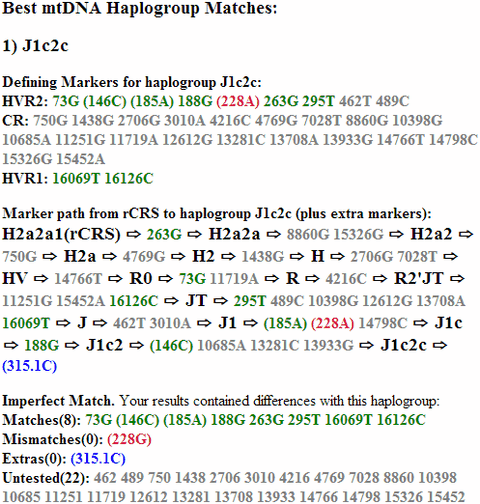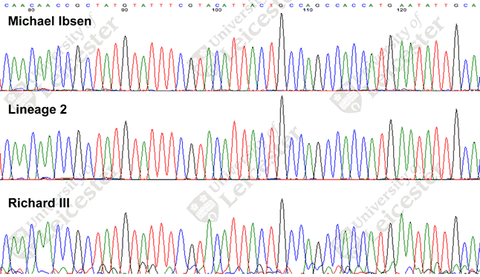(Followup to my previous post about Richard III’s mtDNA.)
When I posted earlier today, I was aware that Joy and Michael Ibsen who are descendants of Richard III’s mother and who would share the same mtDNA sequence had been tested as being in haplogroup J. At the time, I was unaware of and had not been able to find more details about their DNA tests.
It turns out that some details of Joy Ibsen’s test had been published in the book The Last Days of Richard III by John Ashdown-Hill (Kindle link; hardcover and paperback also available) published in 2010. Helen Riding was kind enough to post the results to facebook:

This isn’t a full sequence, and only a subset of HVR1 and HVR2 were sequenced, but this gets us 682bp of sequence, significantly better than the 53bp we have for Richard III. (There are two sequencing results because it was sequenced twice by separate labs.)
So let’s see what this reveals to us in mthap. First, let’s convert that table to a format usable by mthap and save that to a file:
16069T 16126C
73G 146C 185A 188G 263G 295T 315.1C
Next we’ll again visit the advanced options page because the HVR1 and HVR2 ranges weren’t fully sequenced. This time we want to check HVR1 and enter positions 16020-16390 and check HVR2 and enter positions 58-367. After clicking “Upload” and waiting 10-15 seconds we get this result:

Based on this, Joy Ibsen’s haplogroup is most likely J1c2c. J1c2 is pretty definite. J1c2c is based on optional marker 146C, but since we’re already pretty sure about J1c2, then J1c2c is also a good bet. According to Behar et. al. 2012 the estimated age for this haplogroup is about 4543 years old. J1c2c2 and J1c2c2a are also possibilities but the defining markers are not included in the sequence. (UPDATE 2: J1c2c1 is also possible; see below.) Note that 228A is missing, but it is an optional marker because reversions are very common within J1c.
Now, this isn’t Richard III’s sequence, but I would assume that they wouldn’t be so certain about the DNA matching if they didn’t already know it at least matched this much. Therefore it is likely that Richard III was also J1c2c. We’ll have to wait for more details on his sequence to be released to be sure.
UPDATE: This Science News article also says that Ibsen and the Richard III remains are J1c2c.
UPDATE 2: The above originally omitted J1c2c1 as a possibility due to lack of the 222T marker. Based on Ian Logan’s observations, 222T is an unstable marker prone to reversion, so lack of this marker is not necessarily significant. J1c2c1a would still be excluded.
